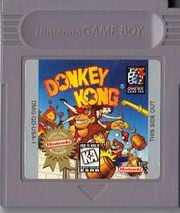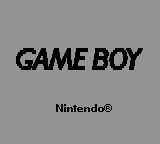Game Boy Color
It has been requested that this article be rewritten and expanded to include more information.
- "GBC" redirects here. For the Game Boy Camera, see Game Boy Camera.
Template:System-Infobox Template:Quote2
The Game Boy Color is the successor to the Game Boy, Nintendo's third handheld system, and in some ways, the handheld counterpart of the Nintendo 64. It is similar to its predecessors, the most notable differences being that it is lighter, capable of displaying multiple colors and that the processing power is twice as fast. It is the final handheld to feature 8-bit graphics.
Some games made for the original Game Boy display more colors if played on a Game Boy Color. Other games were made exclusively for the Game Boy Color. The older versions could not play these, but the Game Boy Advance, the Game Boy Advance SP and the Game Boy Player could. It also had the shortest lifetime of a Nintendo handheld, as it was discontinued in 2003, and the last game was released later the same year.
Like the original Game Boy, the Game Boy Color has the same buttons. These are ,
,
,
buttons and the
. There are no compatibility issues with games made for the original Game Boy being run on a Game Boy Color. All games, accessories that are programmed for a particular game (such as a Game Link Cable), and non-standard features (such as the camera protruding out of a Game Boy Camera cartridge) will work on a Game Boy Color. Playing games that didn't have any color can now be played in color using a color palette by using a combination of
and
,
, or no additional button being pressed to select presets, similar to the Super Game Boy how someone can change the colors the typical monochrome display.
A device known as the Game Boy Horror, modeled after the Game Boy Color, appears in Luigi's Mansion.
Game Boy Color games are currently available through the Nintendo 3DS Virtual Console service.
Hardware Specifications
- CPU: Zilog Z80 (customized)
- CPU Speed: 8 Mhz
- RAM: 16 kB
- Resolution: 160x144 pixels (Same as Game Boy)
- Colors: 32,768 (15-bit RGB)
- Maximum number of colors on screen: 56
- Maximum sprite size: 8x16 or 16x8 pixels
- Maximum number of sprites on screen: 40 sprites, 10 per scanline (Same as Game Boy)
- Maximum number of colors on sprite: 4 (Same as NES)[1][2]
- Minimum/Maximum cartridge size: 256 kb - 64 mb[3]
- Sound: 4 channels
Compatibility Modes
All older cartridges are compatible with the Game Boy Color but not always the other way around. Here is a chart to explain.
| Example Cartridge | Usual Color | Game Boy mode | Super Game Boy mode | Game Boy Color mode | |
|---|---|---|---|---|---|
| Original Game Boy Cartridge | 
|
Gray | Varies from game to game | ||
| Game Boy Color Cartridge (Black) | 
|
Black | Varies from game to game | ||
| Game Boy Color Cartridge (Clear) | 
|
Clear |
Accessories
 This section is a stub. You can help the Super Mario Wiki by expanding it.
This section is a stub. You can help the Super Mario Wiki by expanding it.
All official accessories compatible with the Game Boy are compatible with the Game Boy Color
Game Link Cable
The same link cable that Game Boy and its variations use can be used on Game Boy Color.
Game Boy Printer
The Game Boy Printer that was used to print pictures from the player's Game Boy. This accessory gained some extended support when the Game Boy Color was released, such as being used in Super Mario Bros. Deluxe in Toy Box mode viewing albums.
Mobile Adapter GB
Only available in Japan, the Mobile Adapter GB allowed certain games to connect to some Japanese mobile phones. The only Mario games to utilize it were Mobile Golf and Mario Kart: Super Circuit. This peripheral was referred to as the Mobile Game Boy Adapter in a translated Iwata Asks interview.
IR Communication
There is an Infrared LED, indicated by the black rectangle on top of the unit, that a Game Boy Color can use. This was the primary method in which Mystery Gift worked in the Generation II Pokémon games, but Super Mario Bros. Deluxe can make use of this feature by sending high scores and other data to other copies.
BIOS Colors
These colors will also work on a Game Boy Advance, a Game Boy Advance SP and a Game Boy Player when a Game Boy game is inserted.
| No input |  Brown |
 Pale Yellow[4]/Pastel Mix[5] |
 Blue |
 Green |
|---|---|---|---|---|
 Red |
 Orange |
 Dark Blue |
 Dark Green | |
 Dark Brown |
 Yellow |
 Original Gray |
 Reverse |
The Game Boy Color will display a unique hardware-coded palette of colors for some titles using an internal list of original Game Boy games. One such instance is Super Mario Land.
System gallery
Standard Colors
Special Editions
Game gallery
Trivia
- The Game Boy Color, the Nintendo GameCube, and the Wii U were all released on the same day of their respective years in the Americas.
- This is Nintendo of Australia's first portable console.
- Each letter from the word "COLOR" in the logo is displayed in one of the system's five launch colors.
- In many English-speaking countries (e.g. Canada, Great Britain, and Australia), the correct spelling for color is colour. Despite this, the name of the console was never changed outside of America to reflect this difference.
- The Chronicle in Super Smash Bros. Brawl does not treat the Game Boy Color as separate from the original Game Boy.
References
| Game Boy Color games | |
|---|---|
| Super Mario franchise | Super Mario Bros. Deluxe (1999) • Mario Golf (1999) • Mario Tennis (2000) • Mobile Golf (2001) • Mario Family (2001) |
| Donkey Kong franchise | Donkey Kong GB: Dinky Kong & Dixie Kong (2000) • Donkey Kong Country (2000) |
| Wario franchise | Wario Land II* (1998) • Wario Land 3 (2000) |
| Other | Game & Watch Gallery 2* (1998) • The Legend of Zelda: Link's Awakening DX* (1998) • Game & Watch Gallery 3* (1999) |




























